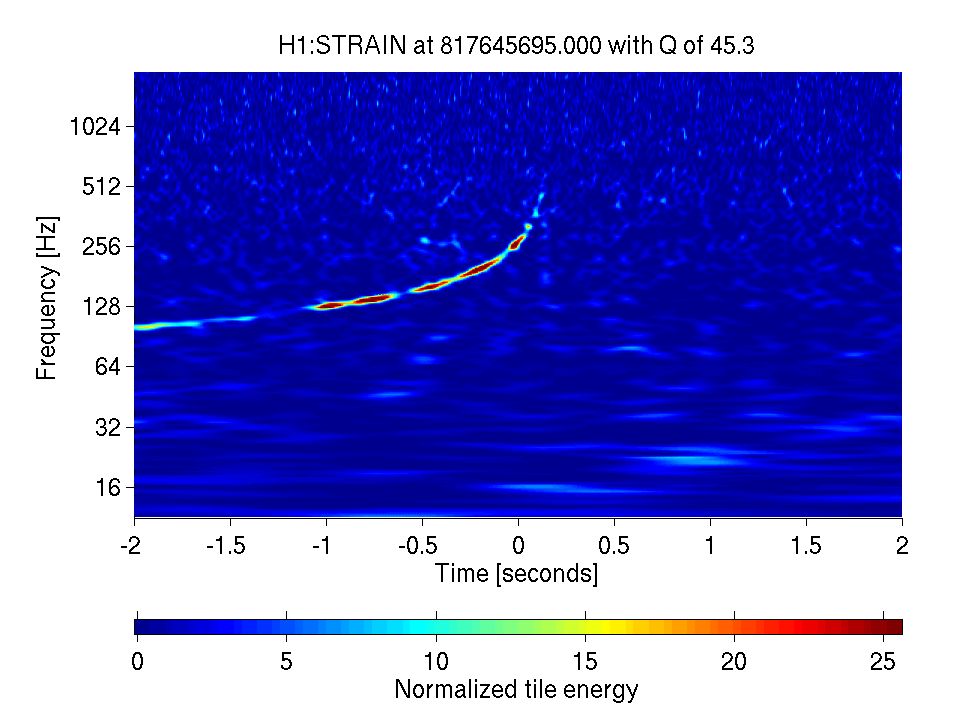O1 Transient Hardware Injections
Hardware Injections
During Advanced LIGO's first observing run (O1), simulated signals were added to the LIGO detectors for testing and calibration. The simulated signals are known as hardware injections, because they were created by manipulating mirrors in the arms of the interferometers. Times of hardware injections are marked in LIGO data files by injection data quality channels. See the injection bit mask definition for details.
Further details on hardware injections are in Validating gravitational-wave detections: The Advanced LIGO hardware injection system available from arXiv:1612.07864 [astro-ph.IM] and doi:10.1103/PhysRevD.95.062002.
Compact Binary Coalescence Injections
Compact Binary Coalescence (CBC) injections were added at planned times throughout O1. Each CBC injection used a waveform to approximate the signal expected from the inspiral, merger, and ringdown of a binary neutron star system, a neutron star with a black hole, or a binary black hole. A spectrogram of a sample injection can be seen in the image on this page.

Burst Injections
Burst injections include ad-hoc transient injections, as described for S6 burst injections.
Stochastic and Detector characterization Injections
These injections all happened in times when GWOSC does not have data, i.e. the DATA bit is off.
Tables of Transient Injections
Each injection is listed with the following information:
- GPS: The GPS time of the end of the injection, or the "merger" time, in GPS seconds
- Mass1 / Mass2: The mass, in solar units, of each compact object
- Dist: The distance to the simulated source in Mpc.
- Exp. SNR: The expected SNR of the injection.
- Rec. SNR: The recovered matched-filter SNR of the injection, as described in Allen et al. (2011). SNRs from 1-5 are typical for times with no signal.
- Type: The category of transient
- Waveform: The name of the waveform used internally by the LIGO Scientific Collaboration.
Tables of transient injections:
Segment Lists when Injections are Not Present
In addition to the log files shown above, information about injection-free times is available in segment lists from the Timeline application.
- The NO_CBC_HW segment lists show times when CBC injections were not present H1 | L1
- The NO_BURST_HW segment lists show times when Burst injections were not present H1 | L1
- The NO_CW_HW segment lists show times when CW injections were not present H1 | L1
- The NO_STOCH_HW segment lists show times when stochastic injections were not present H1 | L1
- The NO_DETCHAR_HW segment lists show times when detector characterization injections were not present: H1 | L1
O1 Continuous Wave Hardware Injections
Continuous Wave Injections
Continuous Wave (CW) injections (also known as pulsar injections) were added throughout O1. Each CW injection corresponds to a simulation of a gravitational wave signal of the form expected from a rapidly rotating, isolated neutron star (often observed as a radio pulsar).
The CW injection system was not active at all times during the run. For a list of times when this system was NOT active, see the O1 CW no-Injection Timelines, or the segment lists ( H1 | L1)
The parameters are defined as in arxiv:0508096. The parameters f0 and phi0 are both defined at a reference time (epoch) which are chosen to be to either the beginning of LIGO's 3rd science run (S3, GPS 751680013 == 2003-11-01T00:00:00 UTC), or at the start of Virgo's 2nd run (VSR2, GPS 930582085 == 2009-07-02T15:01:10). Two additional parameters are also listed for each simulated pulsar:
Aplus = 0.5*h0*(1 + cos2(iota)) Across = h0*cos(iota)
For more information:
- The recovery of similar pulsar hardware injections is described in the following papers from the LIGO Scientific Collaboration: Phys. Rev. D 85, 022001, 2012 (arXiv).
- The recovery of a few simulated pulsars in Virgo data is described in Astrophys.J.737:93,2011 (arxiv).
- A search for pulsars in O1 data is reported in arXiv:1701.07709.
- A search for pulsars in S6 data is reported in Astrophys. J. 785:2,2014 (arXiv).
- A search for pulsars in S5 data is reported in Astrophys. J. 713:1, 2010 (arXiv).
